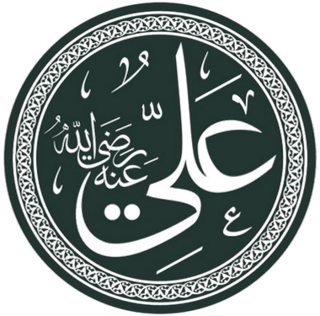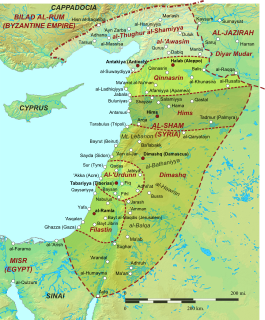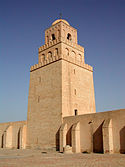Related Research Articles

The Banu Hilal was a confederation of Arabian tribes from the Hejaz and Najd regions of the Arabian Peninsula that emigrated to North Africa in the 11th century. Masters of the vast plateaux of the Najd, they enjoyed a somewhat infamous reputation, possibly owing to their relatively late conversion to Islam and accounts of their campaigns in the borderlands between Iraq and Syria. They participated in the pillage of Mecca in 930. When the Fatimid Caliphate became masters of Egypt and the founders of Cairo in 969, they hastened to confine the unruly Bedouin in the south before sending them to Central North Africa.

Alī ibn Abī Ṭālib was an early Islamic leader. Ali is revered by Sunni Muslims as the fourth Rightly Guided Caliphs, and as a foremost religious authority on the Qur'an and Fiqh. Shi'a Muslims consider him the First Imam appointed by the Islamic prophet Muhammad and the first rightful caliph. Ali was the cousin of Muhammad, and after marriage to Fatimah he also became Muhammad's son-in-law.

Abd Manaf al-Mughirah ibn Qusai was a Qurayshi and great-great-grandfather of the Islamic prophet Muhammad. His father was Quṣai ibn Kilāb.
Hilal or Al-Hilal may refer to:
Hasanwayhids or Hasanuyid was a powerful Shia Kurdish dynasty reigning the western parts of Iran such as Iranian Azerbaijan and Zagros Mountains between Shahrizor and Khuzestan from c. 959 to 1015. The last Hasanwayhid ruler died in 1015 in Sarmadj, south of Bisotun, as the Seljuks began entering the region.
The Banu Sulaym is an Arab tribe that dominated part of the Hejaz in the pre-Islamic era. They maintained close ties with the Quraysh of Mecca and the inhabitants of Medina, and fought in a number of battles against the Islamic prophet Muhammad before ultimately converting to Islam before his death in 632. They took part in the Muslim conquest of the Levant, and established themselves in al-Jazira, whilst part of the tribe remained in the Hejaz. During the early Muslim era, the tribe produced notable generals such as Safwan ibn Mu'attal, Abu'l-A'war and Umayr ibn al-Hubab. Those who remained in Arabia were largely absorbed by the Banu Harb of Yemen beginning in the 9th century, while those in Syria, Mesopotamia were expelled to Upper Egypt by the Fatimid Caliphs in the late 10th century for assisting the Qarmatians. In the mid-11th century, a prolonged famine in Egypt prompted the tribe to migrate westward with the Banu Hilal into Libya. The Sulaym and its sub-tribes established themselves mainly in Cyrenaica, Libya, where until the present day, many of the Arab tribes of that region trace their descent to the Sulaym.
Shihab al-Din abu l-‘Abbas Ahmad ibn Mohammed ibn Mohammed ibn Ahmed ibn Ali ibn 'Abd ar-Rahman ibn Abi'l-'Afiyya al-Miknasi az-Zanati, known simply as Ahmad ibn al-Qadi or Ibn al-Qadi (1552/1553–1616), was a Moroccan polygraph. He was the leading writer from Ahmad al-Mansur's court in Morocco next to Abd al-Aziz al-Fishtali. He was also a renowned judge and mathematician.
Abu Zaid Abd al-Rahman Abu Muhammad Ibn Abd al-Qadir al-Fasi was a Moroccan writer in the field of law, history, astronomy and music. He wrote some 170 books and has been called the Suyuti of his time. He was born in the prominent family of al-Fasi and he was a follower of his father, the Sufi saint Abd al-Qadir Ibn Ali Ibn Yusuf al-Fasi (1599–1680).
Abū'l-Ḥusayn Hilāl b. Muḥassin b. Ibrahīm al-Ṣābi' ابو حسين هلال بن محسن بن ابراهيم الصابئ) was a historian, bureaucrat, and writer of Arabic. Born into a family of Sabian bureaucrats, al-Ṣābi converted to Islam in 402-403 A.H/1012 AD. First working under the Buyid amir Ṣamṣām al-Dawla, he later became the Director of the Chancery under Baha' al-Daula's vizier Fakhr al-Mulk.

Jund Qinnasrīn was one of five sub-provinces of Syria under the Umayyad and Abbasid Caliphates, organized soon after the Muslim conquest of Syria in the 7th century CE. Initially, its capital was Qinnasrin, but as the city declined in population and wealth, the capital was moved to Aleppo. By 985, the district's principal towns were Manbij, Alexandretta, Hama, Shaizar, Ma'arrat al-Nu'man, Samosata, Jusiya, Wadi Butnan, Rafaniyya, Lajjun, Mar'ash, Qinnasrin, al-Tinat, Balis, and Suwaydiyya.

Hilāl ibn ʿAlī, also known as Muḥammad al-Awsaṭ, was one of the sons of Ali. His mother, Umama bint Abi al-As, was the daughter of Zaynab, and grand-daughter of the Islamic prophet Muhammad and Khadija bint Khuwaylid. His mausoleum was established in Aran, Kashan, Isfahan province, Iran.
Ahmed ibn al-Mubarak al-Sijilmasi al-Lamati (1679-1743) was the author of Kitab Ad-Dahab al-ibriz min kalam sayyidi Abdellaziz. It was written in 1717.
Ali ibn al-Qasim al-Zaqqaq, from Fes, Morocco is one of the most important authors in the field of Maliki common law. He is the author of the well-known Lamiyat al- Zaqqaq, a textbook on judicial procedures (Amal). al-Manhaj al-muntakhab is another work by al-Zaqqaq on Maliki fiqh. al-Lulu al-masun fi sadaf al-qawaid al-uyun is the verse summary of al-Zaqqaq's, al-Manhaj al-muntakhab and the commentary of Ahmed Mohammed al-Maqqari (1632) upon it.
Abu Abd Allah Mohammed ibn Abi al-Qasim al-Sijilmasi was a Moroccan Maliki scholar. He is especially well known for his Sharh al-amal al-mutlaq: al-musammá bi-Fath al-jalīl al-samad fī sharh al-takmīl wa-al-mutamad. It was finished in 1782. According to al-Hajwi, Sijilmasi died of the plague in Boujad on the i ith of Shawwal 1214/1800.
Sijilmasi or Sijilmassi sometimes with Al- (السجلماسي) added may refer to
Abu Muhammad Abd Allah bin Muhammad bin Qasim bin Hilal bin Yazid bin 'Imran al-'Absi al-Qaysi was an early Muslim jurist and theologian.
An-Nu'man ibn Humaydah al-Bariqi was a philosopher in Classical Arab. In addition, he was knight and the leader of the Bariq tribe, located in Bariq of Azd, Yemen and was famous for its glory.
Khalīl ibn Aybak al-Ṣafadī, or Salah al-Dīn al-Ṣafadī; full name - Salah al-Dīn Abū al-Ṣafa Khalīl ibn Aybak ibn ‘Abd Allāh al-Albakī al-Ṣafari al-Damascī Shafi'i. ; he was a Turkic Mamluk author and historian. He studied under the historian and Shafi'i scholar, al-Dhahabi.
Abū Hilāl al-Ḥasan ibn ʿAbdallāh b. Sahl al-ʿAskarī, known also by the epithet al-adīb ('littérateur'), was an Arabic-language lexicographer and literatus noted for composing a wide range of works enabling Persian-speakers like himself to develop refined and literary Arabic usage and so gain preferment under Arab rule. He is best known for his Kitāb al-ṣināʽatayn, Dīwān al-maʽāni, and the Jamharat al-amthāl. However, he composed at least twenty-five works, many of which survive at least in part.
References
- ↑ GAL S II, 348
